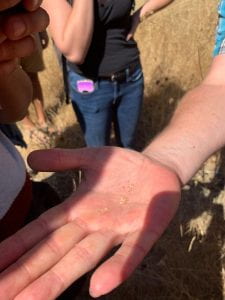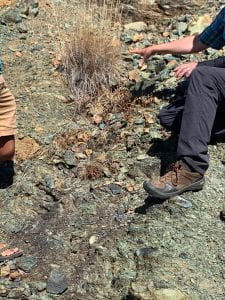On this field trip, our class traveled to Mountain Tamalpais where we were able to view the drastically different environments in which the species, Mimulus guttatus grows. We began the field trip by observing the shaded creek in which there was a large population of lively Mimulus guttatus. The environment consisted of a water bed from the creek and essentially no sunshine because of the shade created by all of the trees. This demonstrates how mimulus can grow without much sunlight. We were then able to collect samples of the species by pulling off the newest leaves from mimulus species that were at least 2 meters away from each other. The samples were places in a plastic tube with silica that would prevent moisture from accumulating and damaging the DNA sample.
After collecting the samples, we traveled a short distance to a very dry area in the middle of a field where all plant life was very much exposed to the sun. In this area, there was a dried up creek that had some dried Mimulus guttatus that was previously seen alive. It is evident that the mimulus would have gotten the needed water from the creek that was there and was also equipped to handle large amounts of sunlight. We were also able to view the inside of a seed pod and view the seeds that species carries. They were incredibly small and thus it could be inferred that animal dispersal from feces or other matters were not a likely form of seed dispersal.
Next, we visited an area that plentiful with serpentine rock where plants have difficulty growing because of the heavy metals that come with the serpentine. The mimulus that were around this area were annual plants, meaning that the plants only grew once a year.
We then walked a further distance and reached an area in which there were many dry plants and sunlight exposure, but there was also a small creek that flowed in a valley. While the plants around the area were mostly dry, there was live mimulus guttatus where the stream was located. These species were flowering and the yellow color as well as the landing space of the petals suggested that bees were the pollinators that aided in seed dispersal of mimulus guttatus.
At the conclusion of the field trip, students were able to determine that Mimulus guttatus has been able to adapt to various environments. This can be due to gene flow that is transferred by bees and other pollinators that allows the plant to have certain traits that help the plant adapt.





Leave a Reply